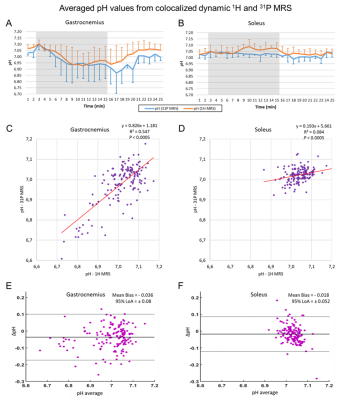Alfredo Liubomir Lopez Kolkovsky1,2, Beatrice Matot1,2, Eric Giacomini1, Martin Meyerspeer3, Benjamin Marty1,2, and Harmen Reyngoudt1,2
1NMR Laboratory, Institute of Myology, Paris, France, 2NMR Laboratory, CEA\DRF\IBFJ\MIRCen, Paris, France, 3High Field MR Center, CMPBME, Medical University of Vienna, Vienna, Austria
1NMR Laboratory, Institute of Myology, Paris, France, 2NMR Laboratory, CEA\DRF\IBFJ\MIRCen, Paris, France, 3High Field MR Center, CMPBME, Medical University of Vienna, Vienna, Austria
An interleaved 1H/31P
multi-voxel sequence for pH monitoring based on carnosine (pH1H,
PRESS) and Pi (sLASER) was extended with a dynamic water reference, removing a
~0.05 bias on pH1H measured during a plantar flexion exercise. pH time
courses (1-min temporal resolution) were comparable.

Figure 5. (A,B) pH values (mean, std) derived from
the co-localized (orange) 1H and (blue) 31P
spectra averaged over 1-min intervals during the exercise paradigm for the
gastrocnemius (left column) and soleus (right column) muscles. The
13-min exercise period is shown (shaded area).
(C,D) Linear correlations and (E,F) Bland-Altman plots between pH1H and pH31P values measured during the exercise paradigm of all subjects. LoA = Limits of agreement.
(C,D) Linear correlations and (E,F) Bland-Altman plots between pH1H and pH31P values measured during the exercise paradigm of all subjects. LoA = Limits of agreement.

Figure 1. A.
Pulse sequence chronogram showing the order of acquisition for each voxel and
nucleus. The RF power was calibrated for each voxel prior to the dynamic acquisition.
B.
The volumes-of-interest, VOI 1 and VOI 2, were placed in the gastrocnemius and soleus,
respectively. Typical voxels dimensions were 2x6x7 cm3. The nominal
regions affected by the excitation pulses are shaded.
